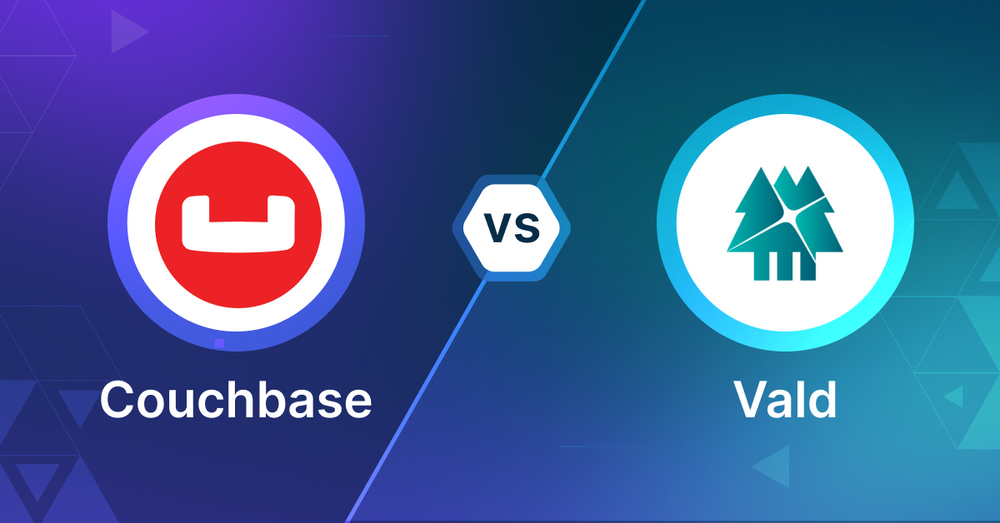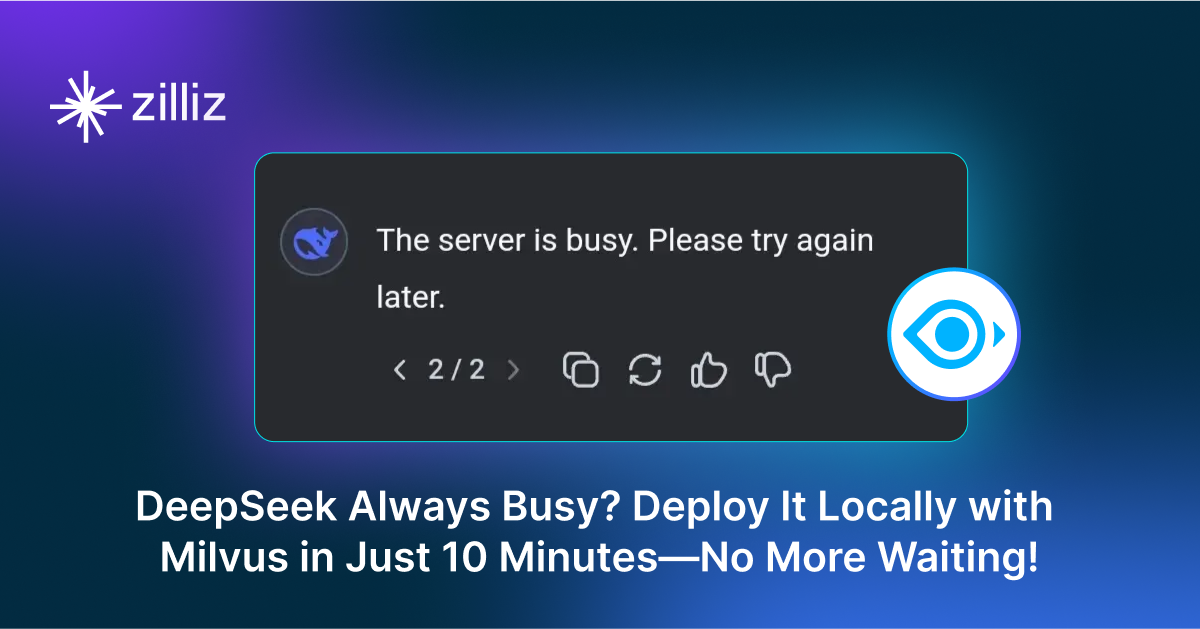Couchbase vs Vald: Choosing the Right Vector Database for Your AI Apps

What is a Vector Database?
Before we compare Couchbase and Vald, let's first explore the concept of vector databases.
A vector database is specifically designed to store and query high-dimensional vectors, which are numerical representations of unstructured data. These vectors encode complex information, such as the semantic meaning of text, the visual features of images, or product attributes. By enabling efficient similarity searches, vector databases play a pivotal role in AI applications, allowing for more advanced data analysis and retrieval.
Common use cases for vector databases include e-commerce product recommendations, content discovery platforms, anomaly detection in cybersecurity, medical image analysis, and natural language processing (NLP) tasks. They also play a crucial role in Retrieval Augmented Generation (RAG), a technique that enhances the performance of large language models (LLMs) by providing external knowledge to reduce issues like AI hallucinations.
There are many types of vector databases available in the market, including:
- Purpose-built vector databases such as Milvus, Zilliz Cloud (fully managed Milvus)
- Vector search libraries such as Faiss and Annoy.
- Lightweight vector databases such as Chroma and Milvus Lite.
- Traditional databases with vector search add-ons capable of performing small-scale vector searches.
Couchbase is distributed multi-model NoSQL document-oriented database with vector search capabilities as an add-on and Vald is a purpose built vector database.
What is Couchbase? An Overview
Couchbase is a distributed, open source NoSQL database for cloud, mobile, AI and edge computing. It combines the best of relational databases with the flexibility of JSON. Couchbase also allows you to do vector search even though it doesn’t have native vector indexes. Developers can store vector embeddings—numerical representations generated by machine learning models—within Couchbase documents as part of their JSON structure. These vectors can be used in similarity search use cases such as recommendation systems or retrieval-augmented generation both based on semantic search where finding data points close to each other in a high dimensional space is important.
One way to do vector search in Couchbase is by using Full Text Search (FTS). FTS is designed for text search but can be used for vector search by converting vector data into searchable fields. For example, vectors can be tokenized into text-like data and FTS can index and search based on those tokens. This will give you approximate vector search and a way to query documents with vectors that are close in similarity.
Alternatively developers can store the raw vector embeddings in Couchbase and do the vector similarity calculations at the application level. This means retrieving documents and computing metrics such as cosine similarity or Euclidean distance between vectors to find the closest matches. This way Couchbase will be used as storage for vectors and the application will handle the math.
For more advanced use cases some developers integrate Couchbase with specialized libraries or algorithms that enable vector search. These integrations allow Couchbase to manage the document store and the external libraries will do the actual vector comparisons. This way Couchbase can still be part of a solution that does vector search.
By using these approaches Couchbase can be used for vector search functionality and be a flexible option for various AI and machine learning use cases that require similarity search.
What is Vald? An Overview
Vald is a powerful tool for searching through huge amounts of vector data really fast. It's built to handle billions of vectors and can easily grow as your needs get bigger. The cool thing about Vald is that it uses a super quick algorithm called NGT to find similar vectors.
One of Vald's best features is how it handles indexing. Usually, when you're building an index, everything has to stop. But Vald is smart - it spreads the index across different machines, so searches can keep happening even while the index is being updated. Plus, Vald automatically backs up your index data, so you don't have to worry about losing everything if something goes wrong.
Vald is great at fitting into different setups. You can customize how data goes in and out, making it work well with gRPC. It's also built to run smoothly in the cloud, so you can easily add more computing power or memory when you need it. Vald spreads your data across multiple machines, which helps it handle huge amounts of information.
Another neat trick Vald has is index replication. It stores copies of each index on different machines. This means if one machine has a problem, your searches can still work fine. Vald automatically balances these copies, so you don't have to worry about it. All of this makes Vald a solid choice for developers who need to search through tons of vector data quickly and reliably.
Choosing Between Couchbase and Vald for Vector Search
When selecting a vector search tool, understanding the key differences between options like Couchbase and Vald is crucial. This comparison will help you make an informed decision based on your specific needs.
Search Methodology
Couchbase doesn't natively support vector search but can be adapted for it. You can use its Full Text Search (FTS) feature by converting vector data into searchable fields. Alternatively, you can store raw vector embeddings and perform similarity calculations at the application level.
Vald, on the other hand, is purpose-built for vector search. It uses the NGT algorithm for fast and efficient similarity searches across billions of vectors.
Data Handling
Couchbase excels in managing structured and semi-structured data. It uses a JSON-based document model, which offers flexibility for storing various data types, including vector embeddings.
Vald focuses primarily on vector data. It's designed to handle and search through massive amounts of high-dimensional vectors efficiently.
Scalability and Performance
Couchbase offers horizontal scaling and can handle large datasets across distributed clusters. However, for vector search, performance may vary depending on the implementation method chosen.
Vald is built for high scalability and performance with vector data. It can handle billions of vectors and uses distributed indexing to maintain performance even during updates.
Flexibility and Customization
Couchbase provides extensive flexibility in data modeling and querying. You can customize how vector search is implemented, integrating with external libraries if needed.
Vald offers customization options for data input/output and integration with gRPC. Its focus on vector search may limit flexibility for other data types.
Integration and Ecosystem
Couchbase has a wide ecosystem and integrates well with various tools and frameworks, especially in the NoSQL and document database space.
Vald is designed to work well in cloud environments and with gRPC, but its ecosystem may be more limited compared to Couchbase.
Ease of Use
Couchbase has a steeper learning curve due to its broad feature set. Implementing vector search requires additional setup and potentially custom code.
Vald, specializing in vector search, may be easier to set up and use for this specific purpose. However, its documentation and community support might be less extensive than Couchbase's.
Cost Considerations
Couchbase offers both open-source and enterprise editions. Costs can vary based on deployment size and support needs.
Vald is open-source, which can reduce upfront costs. However, consider operational costs for managing and scaling the system.
Security Features
Couchbase provides robust security features including encryption, authentication, and fine-grained access control.
Vald's security features may be less comprehensive, focusing primarily on data distribution and backup rather than access control and encryption.
When to Choose Each
Couchbase when you need a database that can handle multiple data types and operations beyond vector search. When you need to implement vector search alongside other database functions. When you need robust security features like encryption, authentication and fine grained access control. When you want to integrate with a wide range of tools and frameworks in the NoSQL and document database space.
Vald when your primary need is efficient vector search at scale. When you need to handle and search billions of high dimensional vectors. When you need high performance and scalability for vector operations. When you want a system that can continue to search during index updates.
Conclusion
Couchbase is flexible and has a broad feature set. It’s good at structured and semi structured data, has lots of customization options and robust security. It can adapt to vector search needs while being a full database solution so it’s a good fit for many use cases.
Vald excels in its focus on vector search. It scales to billions of vectors with ease. Distributed indexing and automatic backups means high performance and reliability for vector search operations.
Your choice between Couchbase and Vald will depend on your needs. Consider the types of data you’ll be working with, the scale of vector operations, your existing infrastructure and your team’s expertise. If you need a multi purpose database with vector search Couchbase might be the way to go. If high performance vector search at scale is your priority Vald might be the better choice. Evaluate your use cases, performance needs and long term goals to make the right decision for your project.
While this article provides an overview of Couchbase and Vald, it's key to evaluate these databases based on your specific use case. One tool that can assist in this process is VectorDBBench, an open-source benchmarking tool designed for comparing vector database performance. Ultimately, thorough benchmarking with specific datasets and query patterns will be essential in making an informed decision between these two powerful, yet distinct, approaches to vector search in distributed database systems.
Using Open-source VectorDBBench to Evaluate and Compare Vector Databases on Your Own
VectorDBBench is an open-source benchmarking tool designed for users who require high-performance data storage and retrieval systems, particularly vector databases. This tool allows users to test and compare the performance of different vector database systems such as Milvus and Zilliz Cloud (the managed Milvus) using their own datasets and determine the most suitable one for their use cases. Using VectorDBBench, users can make informed decisions based on the actual vector database performance rather than relying on marketing claims or anecdotal evidence.
VectorDBBench is written in Python and licensed under the MIT open-source license, meaning anyone can freely use, modify, and distribute it. The tool is actively maintained by a community of developers committed to improving its features and performance.
Download VectorDBBench from its GitHub repository to reproduce our benchmark results or obtain performance results on your own datasets.
Take a quick look at the performance of mainstream vector databases on the VectorDBBench Leaderboard.
Read the following blogs to learn more about vector database evaluation.
Further Resources about VectorDB, GenAI, and ML
- What is a Vector Database?
- What is Couchbase**? An Overview**
- What is Vald**? An Overview**
- Choosing Between Couchbase and Vald for Vector Search
- When to Choose Each
- Conclusion
- Using Open-source VectorDBBench to Evaluate and Compare Vector Databases on Your Own
- Further Resources about VectorDB, GenAI, and ML
Content
Start Free, Scale Easily
Try the fully-managed vector database built for your GenAI applications.
Try Zilliz Cloud for FreeKeep Reading

Zilliz Cloud Introduces Advanced BYOC-I Solution for Ultimate Enterprise Data Sovereignty
Explore Zilliz Cloud BYOC-I, the solution that balances AI innovation with data control, enabling secure deployments in finance, healthcare, and education sectors.

DeepSeek Always Busy? Deploy It Locally with Milvus in Just 10 Minutes—No More Waiting!
Learn how to set up DeepSeek-R1 on your local machine using Ollama, AnythingLLM, and Milvus in just 10 minutes. Bypass busy servers and enhance AI responses with custom data.

The AI Revolution in Marketing: How Vector Databases Are Unlocking True Personalization
Explore how vector databases and AI are transforming marketing platforms, enabling real-time personalization and predictive analytics while balancing automation with creativity.
The Definitive Guide to Choosing a Vector Database
Overwhelmed by all the options? Learn key features to look for & how to evaluate with your own data. Choose with confidence.